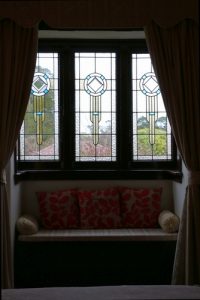 The History Of The Victorian Era Glass Window
The History Of The Victorian Era Glass Window
During the 19th century glass windows were often designed and produced to be in line with classic architectural styles such as Gothic, Tudor and Italianate. These features remained largely in use into the 20th century, even amongst newer ‘Arts and Crafts’ style buildings. During this period, stained glass designs began to move away from their previous dramatic power and narrative interest, in favor of a more reserved style. The background colors were toned down in order to emphasize the color of the figures and clothing. Silver stain was also introduced – this allowed glaziers to add a different color to each part of a design, and was a significant change in glass painting techniques.
History
The Victorian Era was a time of great artistic exploration. Queen Victoria’s open-mindedness allowed artists and architects to explore new glass styles and interpretations. The development of glass that possessed a broad range of visual effects without painting was a result of this, particularly in the early 19th century. These effects were achieved through flashed colored glass, often in a tertiary color palette, such as rich purple, salmon pink, olive green, claret red, saffron and brown. In addition, patterned glass was incorporated into many window types to accent architectural details. This was especially the case for windows in houses and buildings that wanted to let light into a room but wanted privacy. In some cases, the pattern was drawn directly on the window and then cut to shape and painted. This was a common practice in medieval windows, but was more expensive and less practical in modern times. Nonetheless, it was still popular in many churches and homes of the period.
Styles
The Victorian Era was a time of huge change for Britain’s architecture and industry. It also saw the abolishment of window tax, which encouraged home builders to incorporate larger windows into their designs. The most popular style of windows from this era were sash windows. They feature two or more panels that move behind one another on tracks. The windows were made of timber, and are often painted to match the exterior of the house. While sash windows are still in popularity today, modern glazing options offer better weather protection than authentic single glazed timber. In addition, many homeowners are deciding to opt for a more traditional style of window to retain the authentic charm and curb appeal of their period property.
Materials
Victorian-era windows were made using a range of materials, from wood and fabric to wrought iron. They were also crafted using different shapes and sizes to suit the needs of the homeowners. Glass was a key feature of Victorian windows, used to let in light and create views out. The type of glass used was also a factor in how the window looked. Plate glass was developed in the 18th century, which involved casting molten glass onto a polished table of copper or cast iron. Later, mechanization allowed large sheets of plate glass to be produced cheaply.
Conversely, cylinder glass began as a method of creating broad glass, but instead of the blown glass technique being repeated, the larger cylinder was swung in a trench to make it thicker and more easily shaped into panes. This allowed for larger panes than broad glass and gave better surface quality, making it more suitable for windows. These windows became the standard for homes in Victorian England. They are still an excellent option for modern homeowners who wish to recreate the traditional style and experience market-leading thermal insulation.
Interested in getting some Victorian Era glass windows of your own? Be sure to contact our glass experts here at Smiths’ Stained Glass to learn more about what we can do for all of your window needs!

 The History Of The Victorian Era Glass Window
The History Of The Victorian Era Glass Window